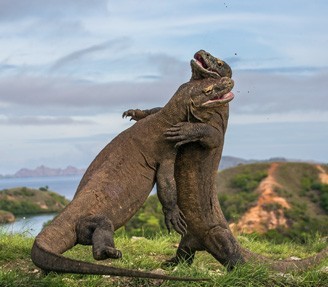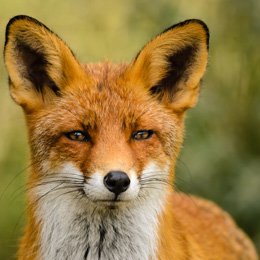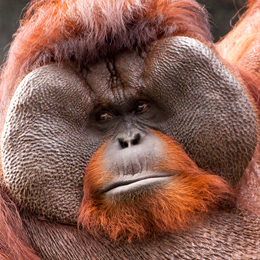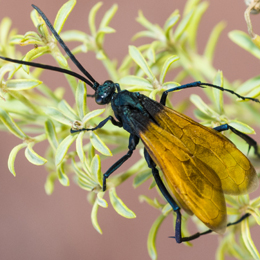Physical Description
The Komodo dragon is the largest living species of lizard that attains a maximum length of 2-3.5 m (6.6-10.5 ft) and weighs around 70-150 kg (150-300 lb). Because of their large size, Komodo dragons dominate the food chain of the ecosystem in which they thrive.
The species exhibits a variety of colors including shades of gray, blue, orange and olive green. Their skin is robust and highly durable because of the presence of bony plates known as osteoderms. It is easy to identify Komodo dragons because of their sheer size, massive heads, bowed legs and the long, thick tail that is often seen whipping in motion. They have long, forked tongues that are used for detecting prey in the wild.
Locally, the Komodo dragon is referred to as ‘ora’ or ‘land crocodile’ because of their gigantic size and prehistoric appearance. It has been found that Komodo dragons, like most monitor lizards, have an average lifespan of around 25-40 years in the wild. Komodo dragons bred in captivity have a smaller lifespan of only 8-10 years.
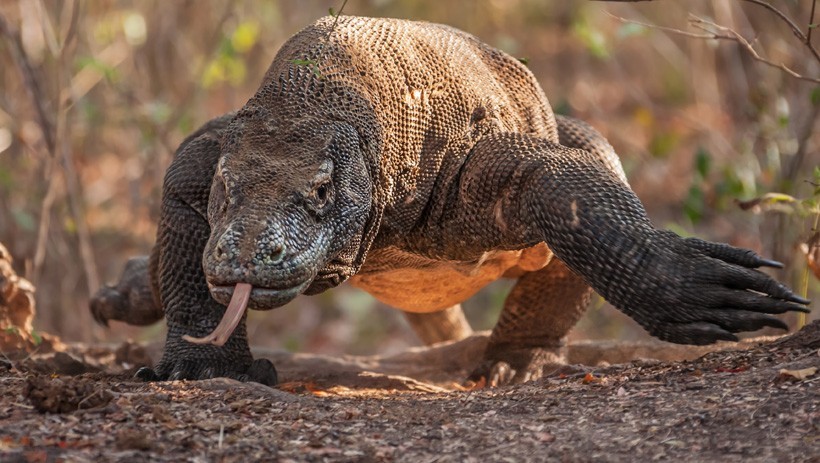
Huge Komodo Dragon quickly comes nearer, Rinca Islands, Indonesia
?
Image credits: Kiwisoul/Shutterstock
Habitat & Distribution
Komodo dragons occupy a limited home range preferring a habitat of deciduous forests and savannah grasslands. While juvenile Komodo dragons are arboreal, adult Komodo dragons are adapted to a terrestrial background although few of them have been found to lead a semi-aquatic lifestyle. They can be found in open lowlands where tall grasses and bushes persist, but may also occur in other habitats like dry riverbeds, beaches and ridge tops.
The species is found on three particular islands that illustrate volcanic environmental conditions. Komodo dragons, therefore, occupy lower monsoon forests and open grasslands up to elevations of 700 meters above the sea level. The Komodo dragon can adapt to harsh environments where rainfall is scarce throughout the year. They can easily survive in landscapes that consist of dry, rocky outcrops where temperatures are high.
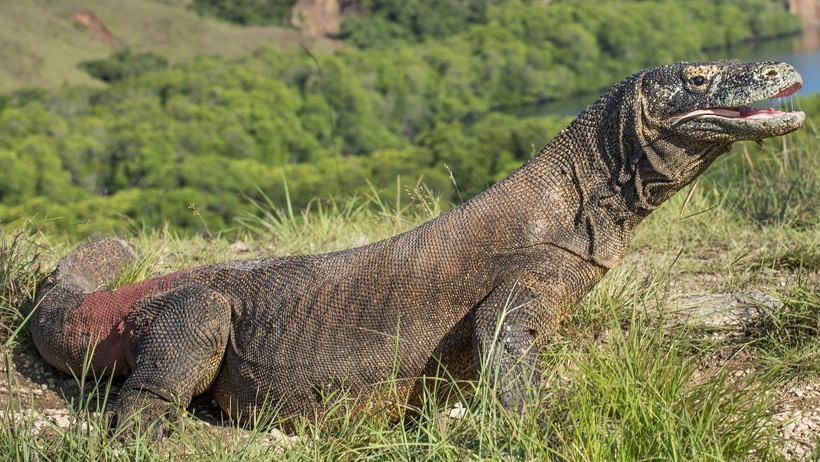
Portrait of the Komodo Dragon, biggest living lizard in the world, Island Rinca, Indonesia
?
Image credits: Sergey Uryadnikov/Shutterstock
Komodo dragons are found on the Indonesian islands of Komodo, Flores, Padar, Rinca and Gili Motang. The Indonesian archipelago of five islands is an integral part of the Komodo National Park that has been sanctioned to preserve the lizard population that faces near extinction. The islands of Indonesia have an extremely hot climate that is usually around 95-97 degrees Fahrenheit with ample humidity to support the lizard population.
Diet
Komodo dragons are carnivorous predators that feed on a large variety of prey. Since Komodo dragons are apex predators within their geographic range and ecosystem, they are large in size, a phenomenon that is commonly known as island gigantism. Their diet primarily consists of carrion. However, the sKomodo dragon also commonly preys on other terrestrial vertebrates like pigs, deer, horses, water buffalo, monkeys, birds and wild boars. They rely on surprise attacks often seizing their prey from a suitable ambush site.
Komodo dragons are also known to be opportunistic scavengers meaning that they can consume dead and decaying remains of animal carcasses. They are even known to raid the graves of human corpses often causing anxiety amongst villagers living nearby. While adult Komodo dragons feed on large sized prey, juveniles often consume snakes, lizards and rodents. They have a voracious appetite and therefore consume prey often more than three to four times a day.
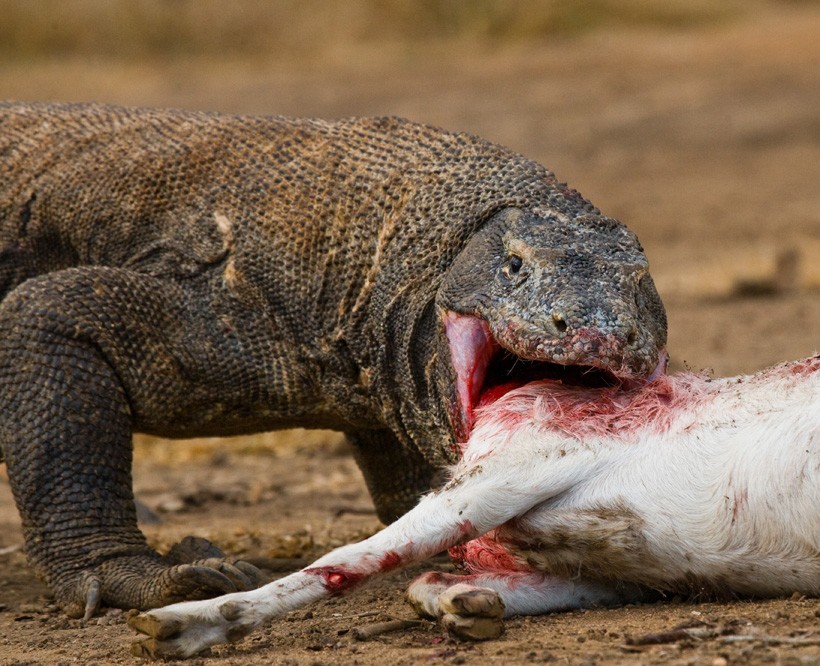
Komodo Dragon eating his prey, Komodo National Park, Indonesia
?
Image credits: Gudkov Andrey/Shutterstock
Feeding Habits
Komodo dragons are apex predators within their ecosystem and usually rely on ambush foraging. A Komodo dragon usually waits for a suitable prey to come along while hiding behind fallen logs, inside burrows or amidst tall grasses. Once the dragon detects a suitable prey, it immediately knocks down the animal using its large feet or through a whip of its tail. Using its large jaw and sharp serrated teeth, it seizes its prey from the underside or the throat while injecting its venom into the prey.
Researchers have been found that the venom of the Komodo dragon is highly toxic and can cause blood clotting and instantaneous death. The saliva of the Komodo dragon contains numerous bacterial strains. If the prey escapes, the saliva of the Komodo dragon is so poisonous that its prey instantly dies. The dragon uses its keen sense of smell to locate the dying animal from as far as 9.5 km.
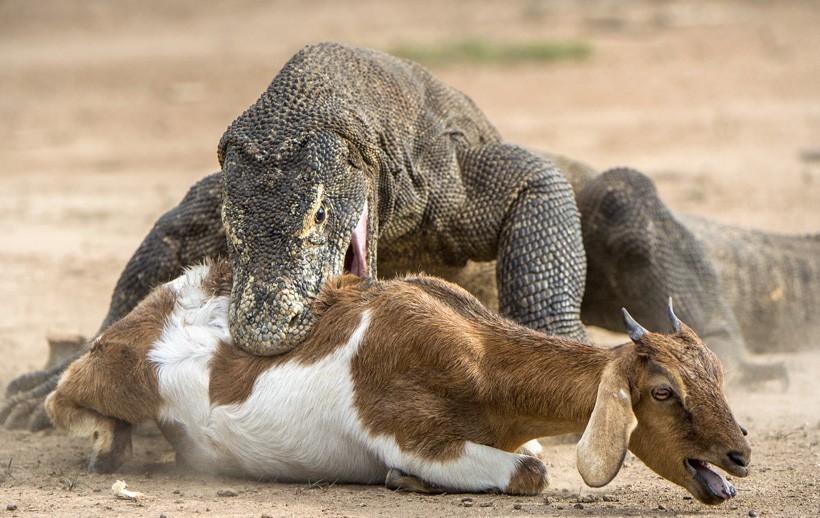
Komodo Dragon attacks prey, Indonesia
?
Image credits: Sergey Uryadnikov/Shutterstock
Komodo dragons usually eat large prey by tearing apart big chunks of flesh while holding down the carcass with their forelegs. Physical adaptations like loosely articulated jaws, a flexible skull and a large stomach make it easy for the species to swallow its prey as a whole. It takes around 15-20 minutes for the dragon to swallow its prey while lubricating the food through copious secretions of red saliva. Komodo dragons may often bask in the sun to facilitate digestion to prevent rotting of undigested food within their stomach that could lead to poisoning. Upon completion of digestion, Komodo dragons often regurgitate parts of their prey like a mass of hair, horns and teeth which together is known as the gastric pellet. The gastric pellet is covered with malodorous mucous that is covered with dirt or sand by the lizard after regurgitation.
Predator
Komodo dragons are apex predators and therefore face a little threat in the wild. However, they are being hunted and killed by humans. Juvenile Komodo dragons usually avoid any form of predation by leading an arboreal lifestyle until they attain physical maturity to protect themselves from larger birds of prey. Komodo dragons are also scavengers and juvenile lizards feed on dead carcasses to limit their foraging hours and prevent predation. If threatened, Komodo dragons can regurgitate their stomach content for lowering their weight for an easy escape.
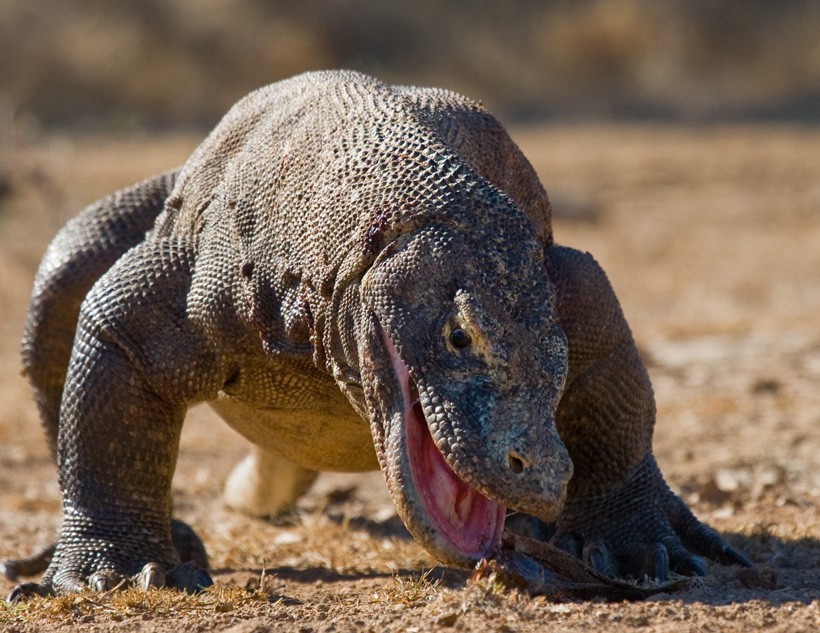
Komodo Dragon on the ground, with open mouth
?
Image credits: Gudkov Andrey/Shutterstock
Anatomy
Komodo dragons are the heaviest lizards in the world with a robust build, dorsoventrally compressed skull and a curved mandible that assists feeding. They have muscular, a long tail, an agile neck, sturdy limbs and a uniformly colored appearance. While adults may possess a stone dull and monotonous skin tone, juveniles usually display vibrant patterns and coloring. The tongue of the Komodo dragon is short and wide, fork-shaped and yellow in color that picks up particles from the air. The species also possess sharp, serrated, laterally compressed teeth that measure around 2.5 cm in length. The teeth are covered almost entirely with a gingival tissue because of which the saliva of the Komodo dragon is usually blood tinged.
The toughened appearance of the Komodo dragon is because of its armored scales that are made up of tiny bones called osteoderms. The muscles found in the jaws and throat of the dragon give it an amazing flexibility to tear down its prey. The intramandibular hinge, which is one of the movable joints, allows the species to open its jaws wide while swallowing. Komodo dragons can stretch their long necks to get a better view of their surroundings. Their toes consist of sharp, recurved claws that are used for holding down prey and climbing trees.
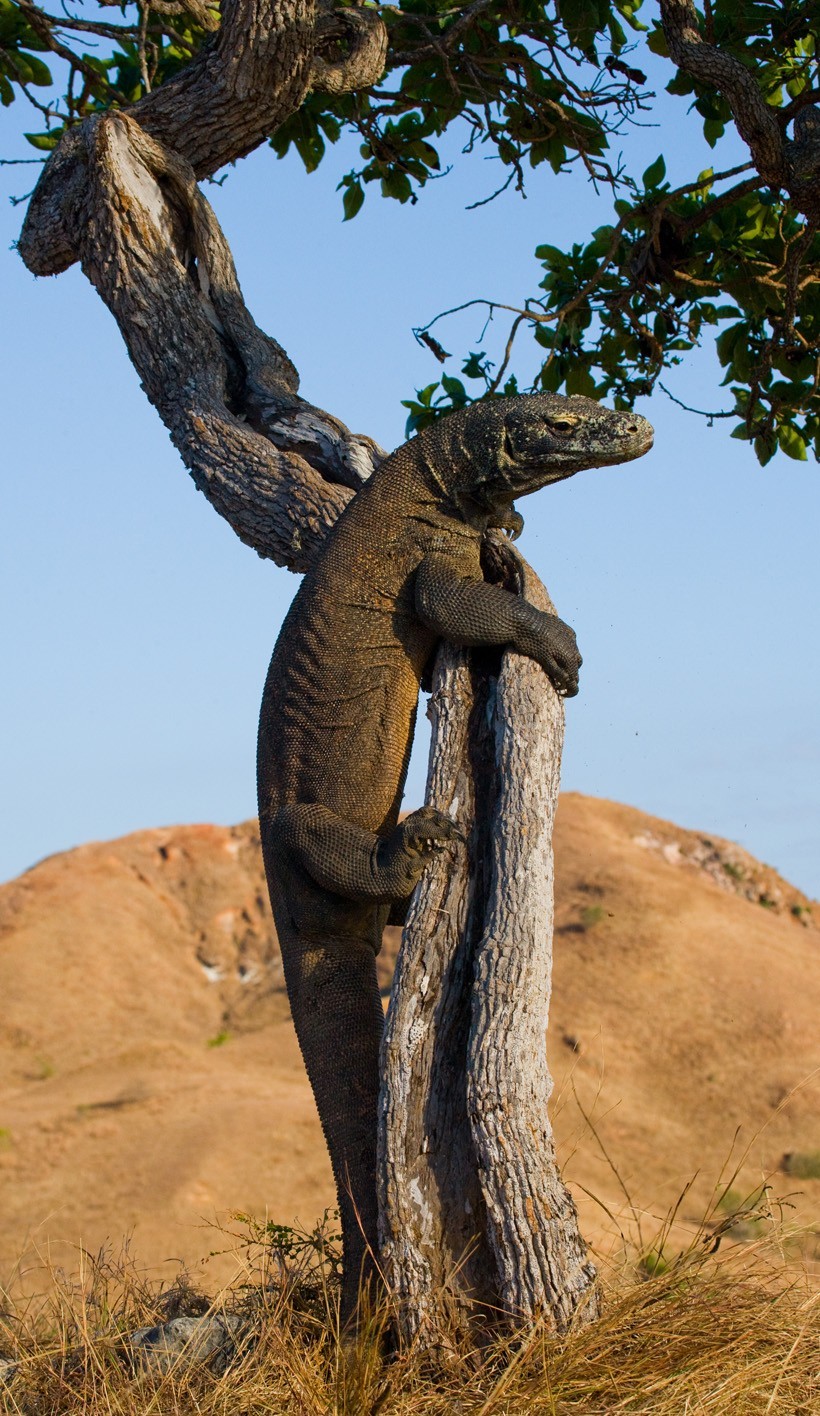
Komodo Dragon climbed a tree
?
Image credits: Gudkov Andrey/Shutterstock
Komodo dragons have distinct anatomical features like a single ear bone, also known as the stapes that transports vibrations or sound from the tympanic membrane into the cochlea. Because of this, the dragon can identify sounds within a range of 400 – 2000 hertz. The species can locate any object as far away as 300 m although it has been reported that the lizard has poor night vision. Komodo dragons use their forked tongues to pick up particles in the air that further stimulate their Jacobson’s organ. The chemical stimulus allows the lizard to detect the presence of an animal in the environment.
The scales on the lizard's body consist of sensory plaques that are connected to nerve tissues. This enhances the ability to sense touch. These sensory plaques are located around the eyes, ears, lips, soles of the feet and the chin. The lower jaw of the species contains venom glands. Komodo dragons usually inject a small doze of venom into their prey that seeps into a large wound made by its teeth. The bite of a Komodo dragon causes localized symptoms like blood clotting, hypothermia, muscle paralysis and body pain.
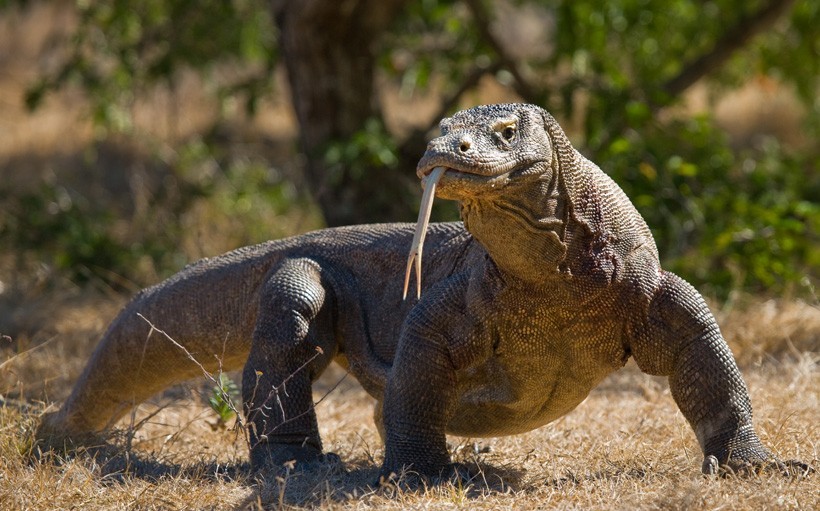
Komodo Dragon is on the ground, Komodo National Park, Indonesia
?
Image credits: Gudkov Andrey/Shutterstock
Reproduction
Komodo dragons are a rare species of lizards that reproduce asexually by parthenogenesis and sexually by mating. They are oviparous lizards that mate during the months of May and August and the breeding may extend until late September. Sexual maturity is attained by both male and female Komodo dragons within a span of 10 years. Breeding is seasonal and polygynandrous which means that they copulate with more than a single mate.
During the mating season, males engage in ritual combat to mate with potential female dragons. Male to male combat consists of males wrestling with each other in an aggressive stand-off. They often wrestle in an upright position while trying to pin down the competitor. A combat may inflict wounds and constant hissing is often observed during such a period when male Komodo dragons become territorial. Female Komodo dragons leave behind scents in their feces allowing potential males to detect their location. The winner acknowledges its female mate by flicking its tongue over her body and rubbing its chin on her head to check if the female is receptive.
Most female dragons are hostile and may resist copulation with their claws and teeth during the initial phases of courtship. Once the female accepts her potential mate, copulation occurs once the male lizard inserts its hemipenes into the female’s cloaca. After mating, the male dragon may stay often with the female to avoid other males from mating with her, a behavioral adaptation that helps the male lizard to preserve its territory.
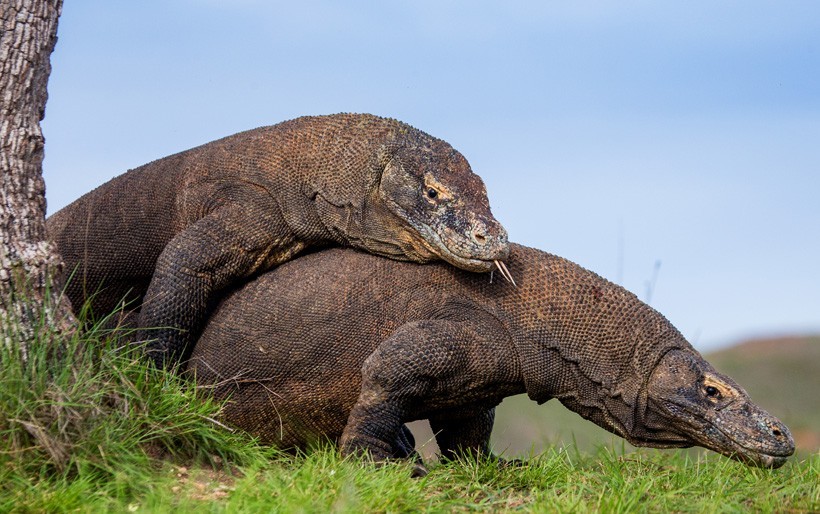
Komodo Dragons mating
?
Image credits: Gudkov Andrey/Shutterstock,
Once copulation ended, females lay eggs by the end of September. The average incubation period for the eggs is around 7-8 months. A unique trait of female Komodo dragons is their ability to select suitable nesting sites. In a particular study, it was found that a gravid female occupied the nest of an orange-footed scrubfowl. Most gravid females either build a nest composed of leaf litter or may occupy abandoned animal burrows as their nesting sites. The average clutch size of Komodo dragons is around 20 eggs that are camouflaged with mud and leaves to prevent other female dragons from consuming them.
Upon hatching, the newborns may stay within their eggshells for hours gaining nutrition from the sac. The average size of newborns is around 35-45 cm in length and their weight is approximately 105 g. They are quite defenseless and are usually abandoned by their mothers at birth. Juveniles often live on trees for 8-9 months till they reach physical maturity and become terrestrial. Young Komodo dragons consume small prey like bird eggs, tadpoles, snakes and rodents. They often roll around in fecal matter and hide inside the dead remains of an animal to deter hungry and cannibalistic adult Komodo dragons.
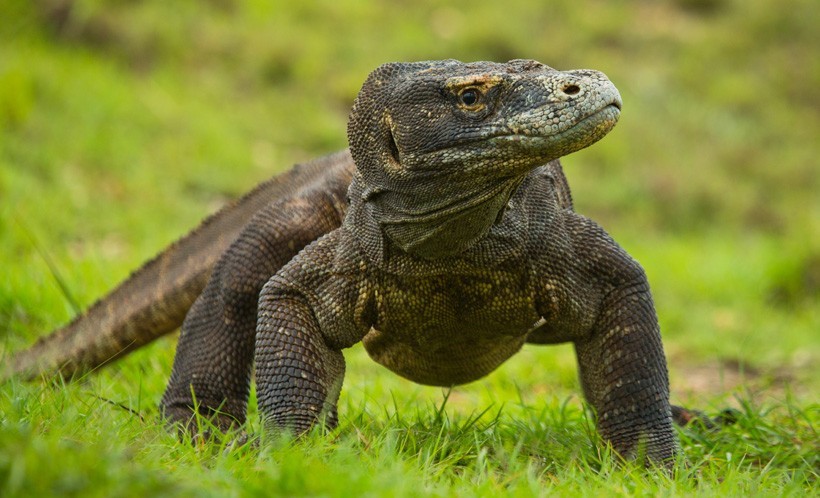
Komodo Dragon Juvenile
?
Image credits: Gudkov Andrey/Shutterstock
Komodo dragons also reproduce asexually through facultative parthenogenesis. According to a recent study conducted in 2005, a Komodo dragon was found to have laid a clutch of eggs at London Zoo that was, in fact, unfertilized eggs. However, parthenogenesis in this species only gives birth to male progeny which allows the species to establish a vital sexually productive population.
Behavior
Komodo dragons are the largest lizards in the world with a limited population that can only be found in the Indonesian archipelago. The lizard is solitary throughout most of its life except during the breeding season where it often corresponds with potential mates. It is highly territorial and is usually active during the day. The species can easily climb trees, swim till depths of 4.5 m and is also capable of running rapidly in short sprints of up to 20 km/h. Very little nocturnal activity has been observed as the species shows poor night vision.
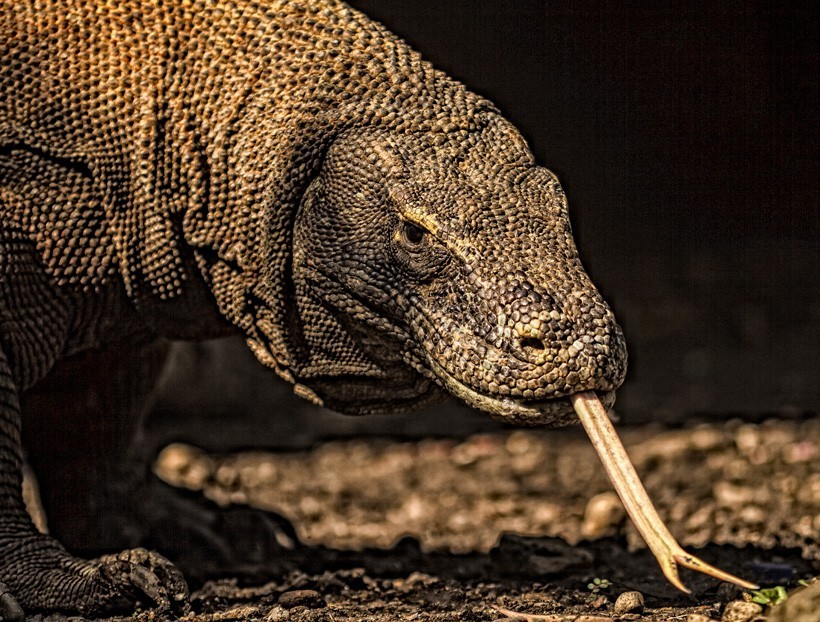
Komodo Dragon forked tongue, closeup
?
Image credits: Soren Egeberg Photography/Shutterstock
The claws and tail are primary weapons for the species to take down prey. Komodo dragons can see as far as 300 m however its sense of smell is far more accurate at detecting food sources. By recognizing airborne molecules using its forked tongue, the lizard is capable of ambushing and seizing its prey using its massive strength, sharp claws and venomous bite. Komodo dragons have often been observed knocking down large prey like pigs and deer using their whip-like tails. Social hierarchy based on size leads to the largest sized lizard consuming prey first while the rest follow.
For building a shelter, Komodo dragons either dig holes or occupy burrows of an appropriate size. Using its powerful claws, it digs a hole that measures around 3-9 feet in size where the lizard often hibernates. During the day Komodo dragons bask under the afternoon sun and at night conserve their body heat by taking refuge in their suitable burrows. During the hottest parts of the day, the lizard may simply rest under a shade. Suitable resting spots are usually located on ridges where the breeze is cool, tree canopy is adequate and vegetation is scarce. Such resting spots are generally considered excellent ambush sites for catching deer.
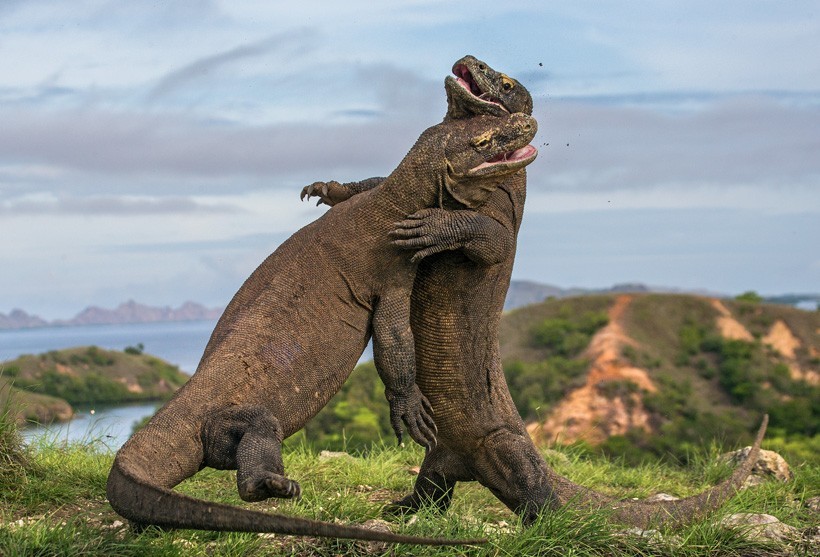
Two Komodo Dragons fighting with each other, Indonesia
?
Image credits: Gudkov Andrey/Shutterstock
Communication between Komodo dragons usually takes place by standing upright to show dominance within a group. During the breeding season, males often rub their chins against a female’s head to show their interest. A Komodo dragon can consume water by sucking it into its mouth through a buccal pumping mechanism where it lifts its head high and lets the water flow down in its throat.
Threats
The Komodo dragon is a gigantic lizard that is found on a few small Indonesian islands. Despite having a fearsome reputation, the lizard actually faces a severe threat to its population. Due to several anthropogenic based activities and natural disasters, their population has suffered a massive decline with approximately 6000 individuals left in existence and only 350 breeding females. Volcanic eruptions, fire and earthquakes have decreased their habitat range while illegal activities like poaching, pet trade and tourism have further limited their number on the islands. According to a recent study, the population of Komodo dragons in Padar became extinct due to both a decrease in their food availability and poaching.
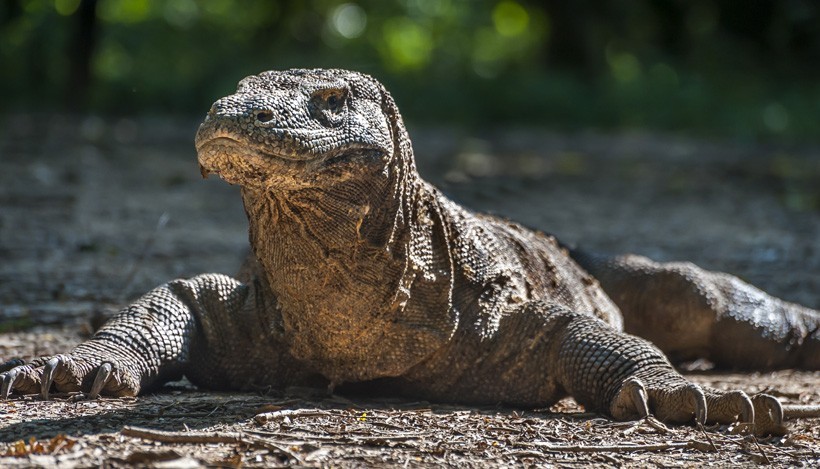
Komodo dragon basking in the sun
?
Image credits: Edmund Lowe Photography/Shutterstock
Conservation
To preserve the population of Komodo dragons in the wild, the IUCN Red List has categorized the species as ‘Vulnerable’. It has also been mentioned in the CITES Appendix II where the commercial trade of the species and their skin is illegal. The Komodo National Park was introduced in 1980 to conserve the species population on the islands Rinca, Padar and Komodo. The Wolo Tado Reserve and the Waa Wuul Reserve also aim to protect Komodo dragon population in Flores. The Australia Zoo is a renowned organization that has introduced a species conservation program for Komodo dragons to preserve their gene pool. Komodo dragons are also being bred in captivity to ensure that the current population of wild Komodo dragons doesn’t face any problems like inbreeding. Few specimens have been displayed in zoos, the first ever being exhibited in 1927 at London Zoo.
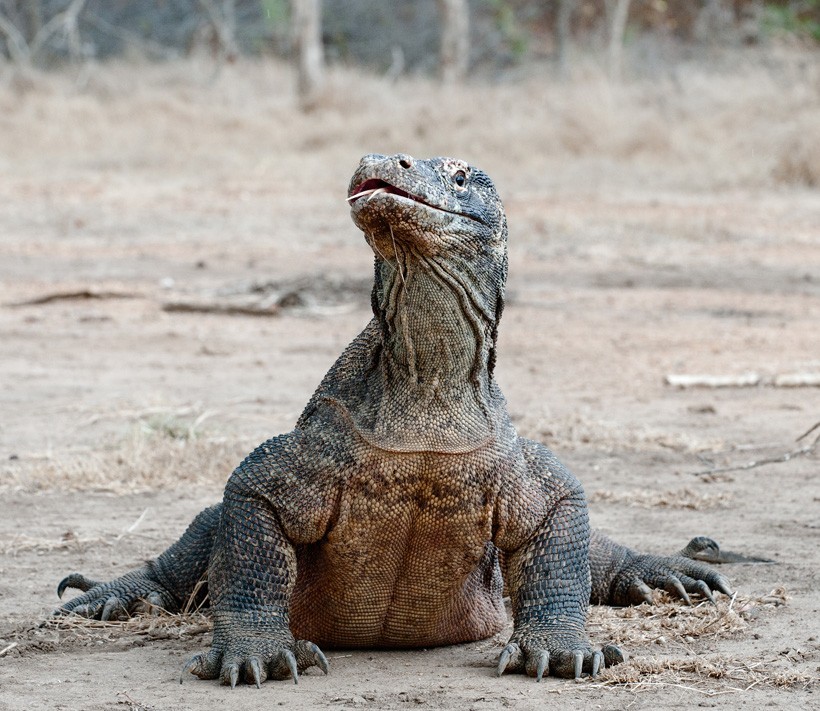
Komodo Dragon smelling the air, Indonesia
?
Image credits: Sergey Uryadnikov/Shutterstock
Funfacts
- Komodo dragons are the largest and heaviest lizards in the world.
- Komodo dragons have been known to occasionally attack humans in the West Manggarai Regency, a region in Indonesia.
- Komodo dragons were first ever documented in 1910 by Western scientists.
- Komodo dragons breathe through a small tube under the tongue even while swallowing their prey.
- Before the male to male combat starts, a Komodo dragon may defecate or vomit to mark its territory.
- Once a Komodo dragon has finished feeding, it costs the animal around 10 – 15 minutes to clean itself by rubbing its mouth against leaves.
- W. Douglas Burden coined the common term ‘Komodo Dragon’ in 1926.
- Komodo dragons are cannibalistic and may even consume their babies if there is scarcity of food.
- George H.W. Bush, former US President, received a Komodo dragon as a gift from the Indonesian government.
- Komodo dragons can consume an amount of food that reflects 80 % of its body weight.
- During the last 40 years, only four humans have been killed by a Komodo dragon.
- Komodo dragons that are bred in captivity have often exhibited playful behavior with inanimate objects and around humans.
- Komodo dragons are opportunistic feeders and voracious scavengers in the wild.
- Because Komodo dragons have slow metabolism, they can survive on a minimum of 12 meals a year.
